Cherry shrimp, like other dwarf shrimp species, appreciate a well-decorated tank with ample hiding spots to feel secure and reduce stress from tank mates like fish and other animals.
Here’s a comprehensive list of good hiding places for cherry shrimp, from the most common to the least common on what are good hiding places for cherry shrimp.
Here’s my list on what are good hiding places for cherry shrimp.
- Plants: Aquatic plants such as Java moss, Java fern, Anubias, Cryptocoryne, Christmas moss, Weeping moss, Flame moss, Vallisneria, Dwarf Hairgrass, and Eleocharis acicularis provide natural and essential hiding places for cherry shrimp while also offering surfaces for biofilm growth.
- Leaf litter: Indian almond leaves
 , oak leaves, or other suitable leaf litter can create hiding spots and provide additional grazing surfaces.
, oak leaves, or other suitable leaf litter can create hiding spots and provide additional grazing surfaces. - Driftwood: Pieces of driftwood in various shapes and sizes create ideal hiding spots and add a natural look to your aquarium.
- Rock formations: Arrange rocks to create nooks and crannies, providing additional hiding places for shrimp.
- Ceramic rings: Ceramic rings provide great hiding spots for baby shrimp and also serve as a suitable surface for beneficial bacteria growth.
- Coconut shells: Halves of coconut shells with a hole drilled in them make for a natural-looking and functional hiding place.
- Terracotta pots: Small terracotta pots or pot fragments can provide a sheltered area for shrimp to hide.
- Sponge filters: Shrimp can hide behind and around sponge filters, which also provide efficient filtration and grazing surfaces for biofilm.
- Cholla wood: Cholla wood has a natural, porous structure that provides hiding spots and grazing surfaces for cherry shrimp.
- Bamboo tubes: Pieces of bamboo cut into small tubes can be used to create natural-looking hiding places for shrimp.
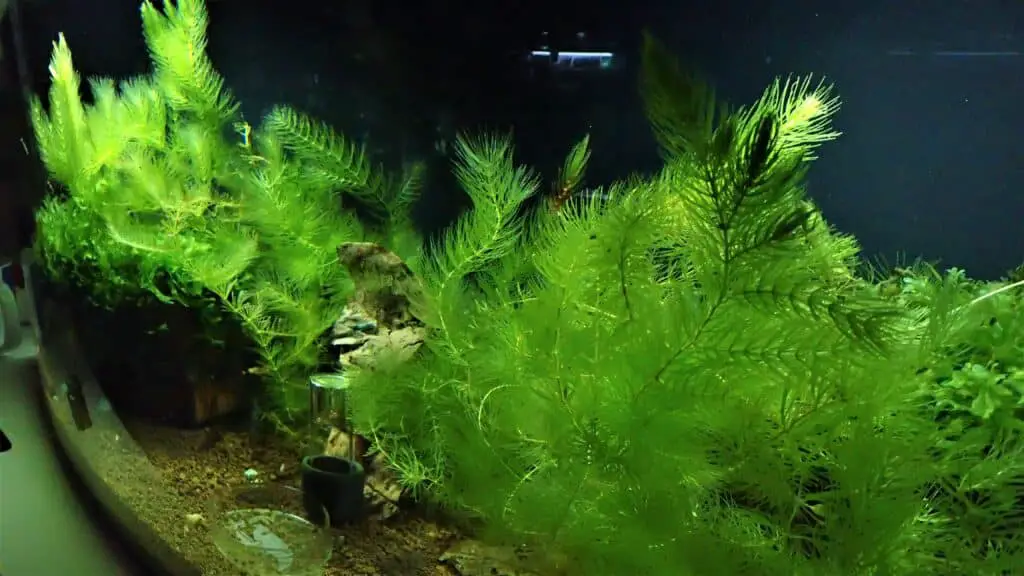
Aquatic Plants Make Great Hiding Spots
Aquatic plants are an essential component of any cherry shrimp tank. They provide multiple benefits, such as offering shelter and hiding spots for shrimps, especially when they molt or feel threatened.
Additionally, live plants are excellent surfaces for biofilm growth, which serves as a primary food source for shrimp.
Some popular plants for shrimp tanks include Java moss, Java fern, Anubias, Cryptocoryne, Christmas moss, Weeping moss, Flame moss, Vallisneria, Dwarf Hairgrass, and Eleocharis acicularis.
These plants not only enhance the tank’s appearance but also help maintain freshwater quality by absorbing excess nutrients and providing oxygen.
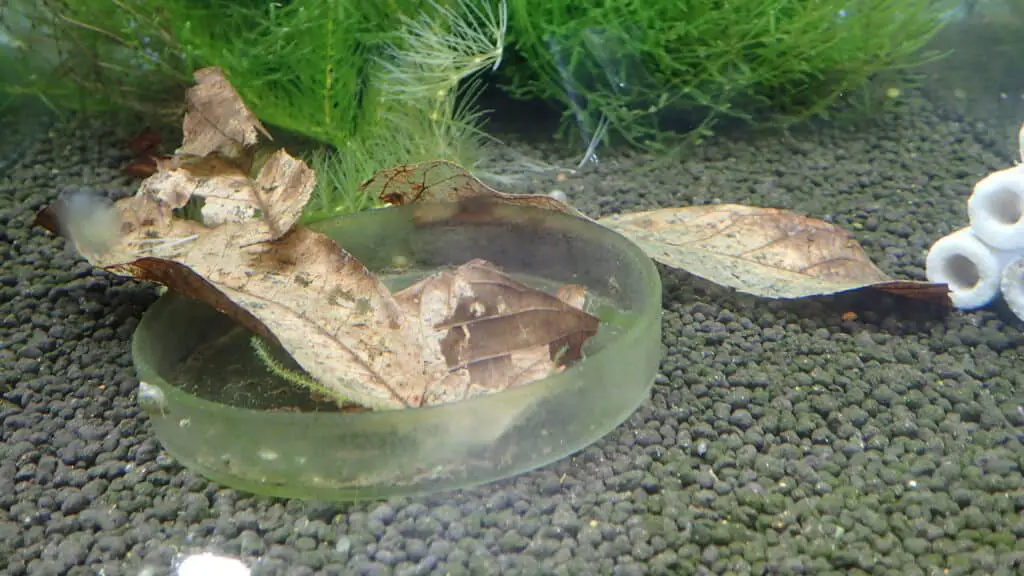
Leaf Litter: Creating a Natural Environment for Cherry Shrimp Tank
Adding leaf litter, such as Indian almond leaves or oak leaves, to a cherry shrimp tank can provide numerous benefits. Leaf litter creates additional hiding spots and contributes to a more natural environment for the shrimp.
As the leaves decompose, they offer grazing surfaces for biofilm, an essential food source for shrimp.
Moreover, leaf litter helps lower the pH levels in the water, creating a more suitable environment for cherry shrimp. When using leaf litter, ensure that the leaves are pesticide-free and thoroughly cleaned before adding them to the tank.
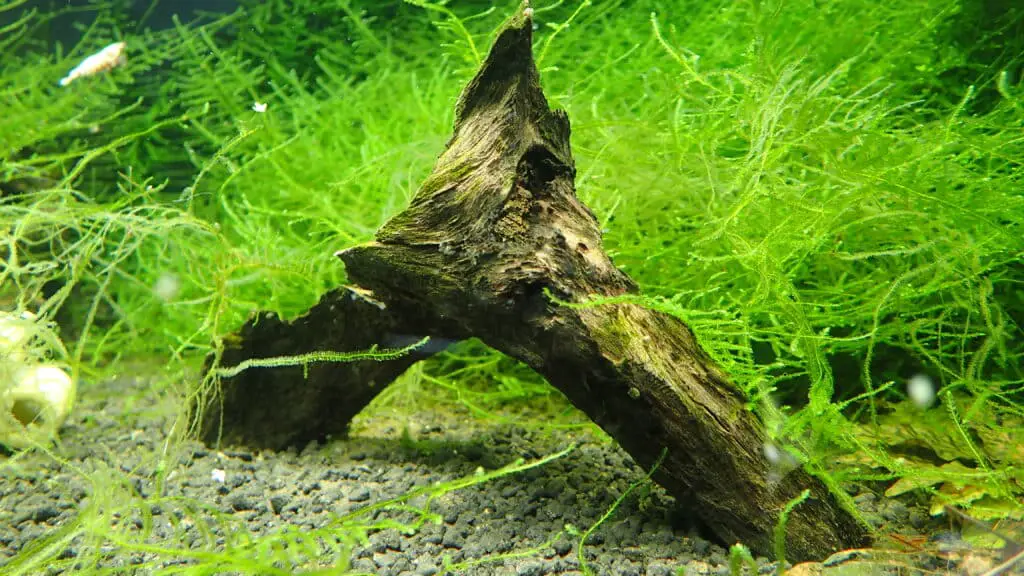
Driftwood: Adding Aesthetic Appeal and Functionality
Driftwood is an excellent addition to any shrimp tank, offering both visual interest and functionality. Various shapes and sizes of driftwood create ideal hiding spots and add a natural look to the aquarium.
When selecting driftwood, make sure it is aquarium-safe and thoroughly cleaned before adding it to the tank. Boiling the driftwood can help remove any potential contaminants and reduce tannins that might discolor the water.
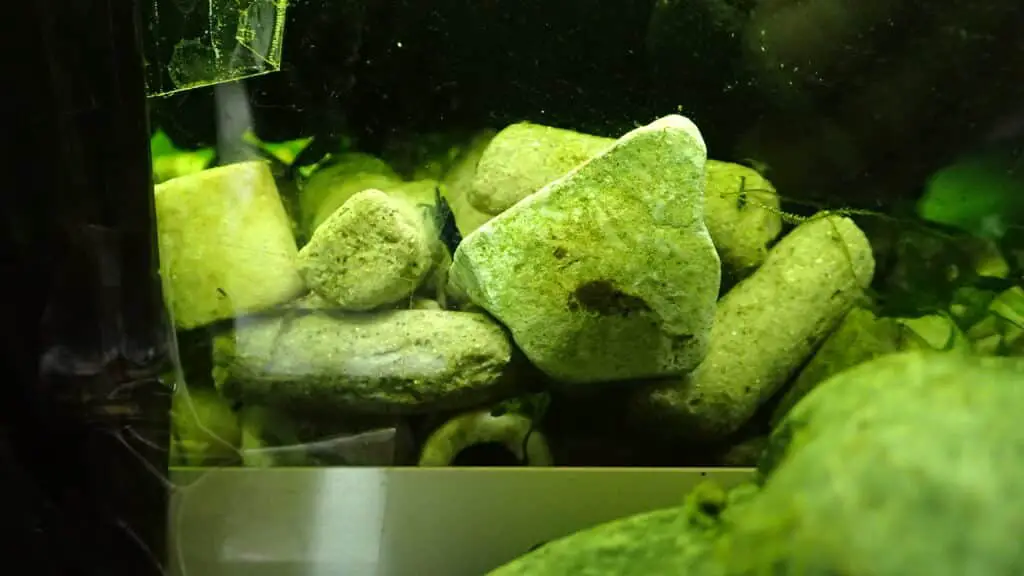
Rock Formations: Help To Hide Shrimp
Rock formations can significantly improve the aesthetics and functionality of a shrimp tank. By arranging rocks to create nooks and crannies, you can provide additional hiding places for your cherry shrimp.
Choose rocks that are aquarium-safe, such as lava rocks, slate, or dragon stone, as some rocks can alter water chemistry. Always clean the rocks thoroughly before adding them to your tank.

Ceramic Rings: Baby Shrimp Hiding Spots
Ceramic rings are a popular choice for creating hiding spots for baby shrimplets in your aquarium. These rings provide a safe and secure environment for the young shrimp to hide and grow without being preyed upon by other fish or larger shrimp.
Additionally, ceramic rings have a porous surface that promotes beneficial bacteria growth, which helps to maintain good water quality in your tank.
When using ceramic rings in your aquarium, it’s important to choose rings that are made specifically for aquatic use, as some ceramic rings may contain glazes or other materials that could be harmful to your shrimp.
Once you’ve found suitable ceramic rings, simply add them to your tank and watch as your baby shrimp take shelter within the nooks and crannies.
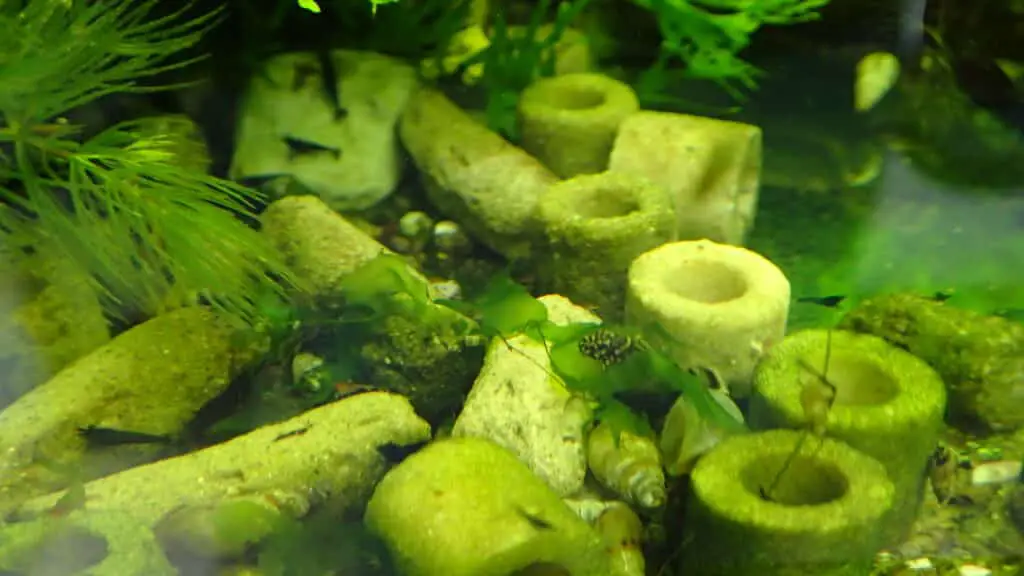
One of the benefits of using ceramic rings is that they can also promote the growth of nitrifying bacteria in your tank. These beneficial bacteria help to break down harmful ammonia and nitrite compounds in the water, which can improve overall water quality and create a healthy environment for your shrimp.
In addition to providing hiding spots for baby shrimp, ceramic rings can also be used in conjunction with other filtration methods to maintain a healthy and stable ecosystem in your tank.

Coconut Shells: A Natural and Functional Hiding Place
Coconut shells are a great option for a natural and functional hiding place for cherry shrimp. They provide a unique and attractive look to your aquarium while also providing the shrimp with a secure hiding spot.
To create a coconut shell hide, simply take a half of a coconut shell, drill a hole in it, and place it in your tank.
Coconut shells can also serve as a source of food for shrimp, as they contain beneficial nutrients and minerals that can aid in their overall health. In addition, coconut shells are long-lasting and can be used for many years in your aquarium.
When using coconut shells in your aquarium, it’s important to make sure they are thoroughly cleaned and free of any potential toxins or contaminants. You can also consider boiling the coconut shell before adding it to your tank to ensure it is completely sanitized.
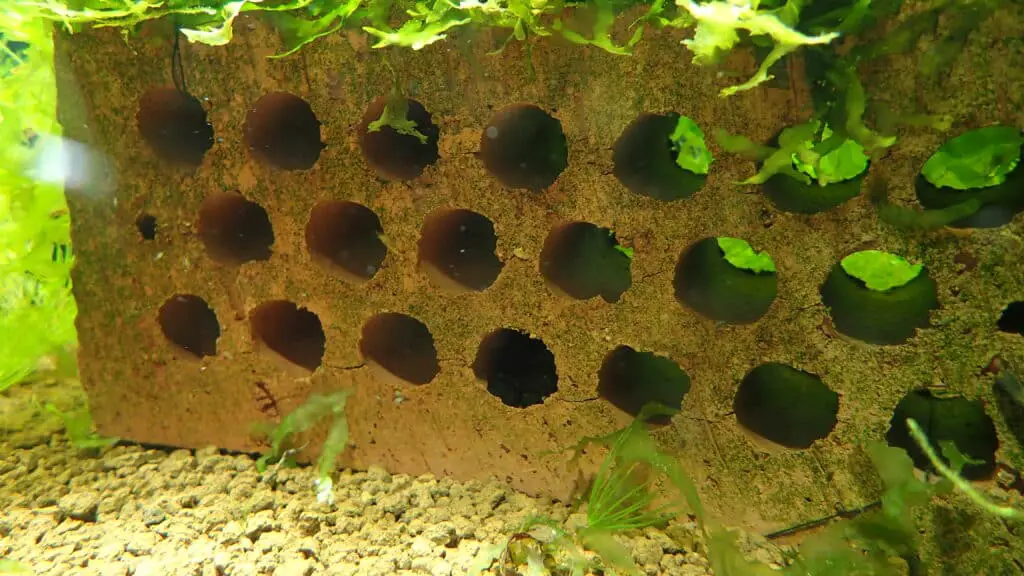
Terracotta Bricks: Affordable and Customizable Hide
Terracotta pots or pot fragments or bricks are an inexpensive and customizable option for providing sheltered areas for shrimp to hide. Simply break or cut a small pot into pieces and arrange them in the tank to create a unique and functional hiding spot for your shrimp.
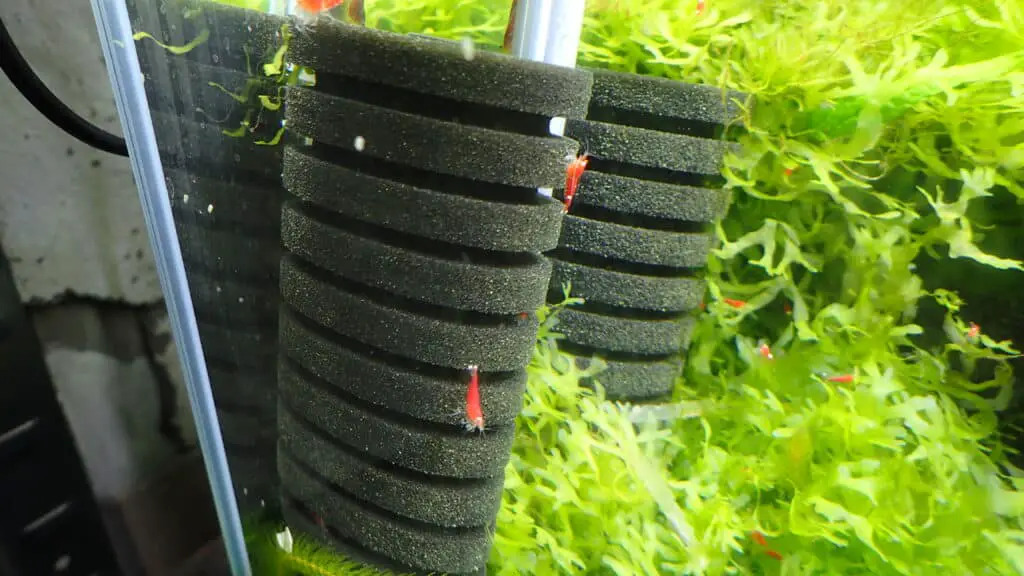
Sponge Filters: A Dual-Purpose Addition
Sponge filters are a popular choice for aquarium enthusiasts, and for good reason. They serve as an efficient filtration system, helping to remove debris and harmful compounds from the water, while also providing a hiding spot for shrimp.
Shrimp can hide behind and around sponge filters, which can make them feel more secure and reduce stress levels.
In addition to serving as a hiding spot, sponge filters also provide a grazing surface for biofilm, which is an essential food source for cherry shrimp. Biofilm is a thin layer of bacteria and other microorganisms that forms on surfaces in the aquarium.
Shrimp will graze on biofilm, picking off individual organisms and consuming them as a source of nutrition. By providing a surface for biofilm growth, sponge filters can help to ensure that your shrimp have a constant source of food.
Sponge filters are also relatively easy to clean and maintain. Simply remove the sponge from the filter and rinse it out in tank water. The sponge can then be replaced back into the filter and put back into operation.
One of the benefits of using sponge filters is that they are gentle on shrimp and other aquatic animals. The slow flow rate of water through the sponge filter means that there is minimal water movement, which can reduce stress levels for your shrimp and help create a more natural environment.
means that there is minimal water movement, which can reduce stress levels for your shrimp and help create a more natural environment.
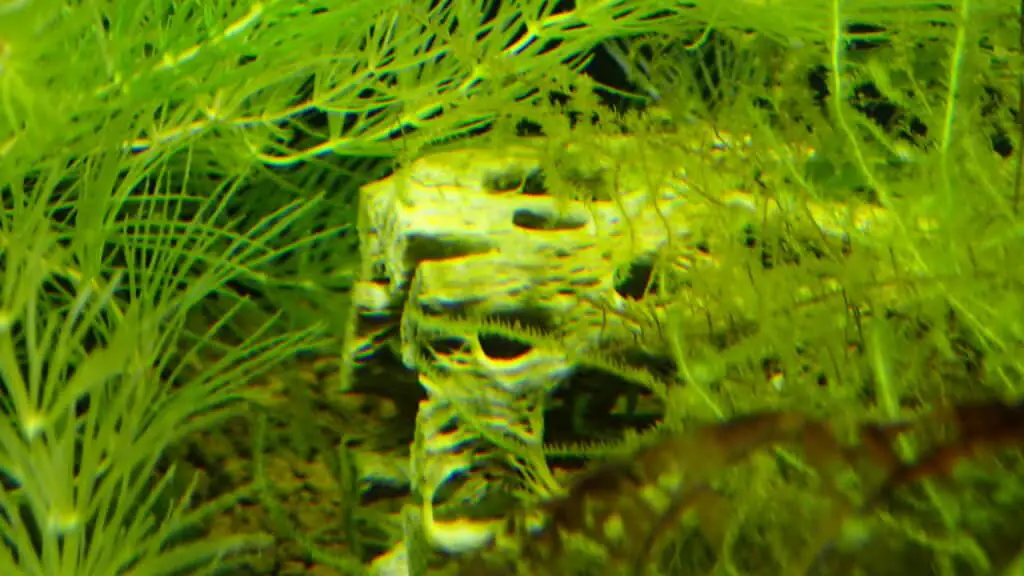
Cholla Wood: A Porous and Natural Shelter
Cholla wood is a popular addition to shrimp tanks due to its natural, porous structure. The wood provides hiding spots and grazing surfaces for rcs, while also contributing to the overall aesthetics of the aquarium.
Cholla wood is derived from a cactus species and is safe for use in shrimp tanks. Make sure to thoroughly clean and prepare the cholla wood before adding it to your tank.
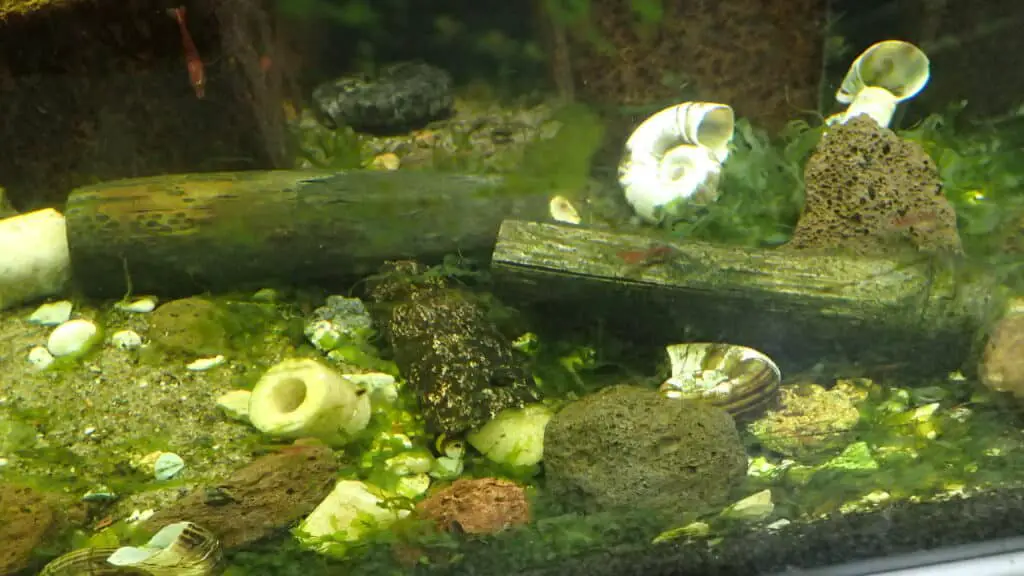
Bamboo Tubes: A Sustainable and Attractive Option
Bamboo tubes are a sustainable and visually appealing option for creating hiding places for cherry shrimp. Cut pieces of bamboo into small tubes and arrange them in your tank to create a natural-looking habitat for your shrimp.
Bamboo is a renewable resource and offers an eco-friendly alternative to other materials. Always ensure the bamboo is clean and free of pesticides or contaminants before adding it to your aquarium.
By combining these hiding spots, you can create a diverse and engaging environment for your cherry shrimp. Remember to use aquarium-safe materials and properly clean and sterilize them before introducing them to the tank.
Here’s a list of items that are not recommended or should be avoided when creating hiding places for cherry shrimp
- Plastic materials: Avoid using plastic decorations, plants, or hiding spots, as they may release harmful chemicals into the freshwater over time and are not eco-friendly.
- Metal objects: Metal can rust or corrode in the aquarium, potentially releasing harmful substances and affecting water quality. Always choose aquarium-safe materials.
- Painted or dyed decorations: Painted or dyed ornaments can release harmful chemicals as the paint or dye breaks down. Opt for natural, untreated materials.
- Non-aquatic wood: Some types of wood can release harmful substances or decompose quickly in water, which can affect water quality. Only use wood types that are safe for aquarium use, like driftwood or cholla wood.
- Uncleaned materials: Always thoroughly clean and sterilize any materials before adding them to the tank to prevent introducing harmful pathogens or contaminants.
- Non-aquarium-safe materials: Some materials, such as certain types of rocks, can alter water parameters or release harmful substances. Always use aquarium-safe materials and research their compatibility with your tank’s inhabitants.
By avoiding these items, you can ensure a healthier and safer environment for your cherry shrimp. Always prioritize using natural and eco-friendly materials to create a thriving habitat for your aquatic pets.
Pre-treating Aquarium Additions with Alum Dip to Prevent Unwanted Pests
Before introducing any new items to your shrimp tank, it’s essential to pre-treat them with an alum dip to prevent the introduction of unwanted pests or pathogens. Alum, or potassium aluminum sulfate, is a chemical compound commonly used in water treatment and as a mordant in dyeing processes.
In aquariums, alum dip acts as a disinfectant, helping eliminate unwanted pests, snails, and algae without harming plants or shrimp.
Here’s a step-by-step guide on how to prepare and use an alum dip for various tank additions
- Prepare the alum solution: Mix one tablespoon of alum powder per gallon of water in a container large enough to accommodate the items you intend to treat. You can find alum powder at grocery stores, pharmacies, or online retailers.
- Pre-treat plants: Gently rinse the plants under running water to remove debris. Then, submerge the plants in the alum solution for 2-3 hours. After the dip, rinse the plants thoroughly under running water before adding them to your tank.
- Pre-treat wood and bamboo: If you’re using new wood or bamboo, it’s essential to soak the items in a separate container of water for a few days to a week before the alum dip. This soaking process helps remove tannins, which can discolor the water, and ensures the wood is waterlogged and will sink in the tank. After soaking, submerge the wood or bamboo in the alum solution for 2-3 hours, then rinse under running water before placing it in your aquarium.
- Pre-treat rocks and decorations: Rinse rocks and decorations under running water to remove any debris. Submerge them in the alum solution for 2-3 hours, and rinse thoroughly before adding them to the tank.
- Pre-treat ceramic rings, coconut shells, and terracotta pots: Soak ceramic rings, coconut shells, and terracotta pots in the alum solution for 2-3 hours, then rinse well under running water before introducing them to your aquarium.
- Pre-treat leaf litter: Briefly rinse leaf litter under running water and soak it in the alum solution for 30 minutes to an hour. After soaking, give the leaves a final rinse before adding them to your tank.
After pre-treating all the items, you can safely add them to your cherry shrimp tank without the risk of introducing unwanted pests or pathogens.
By taking these precautions, you help ensure a healthy and thriving environment for your shrimp.
While pre-treating new items like rocks with an alum dip isn’t always necessary, it’s a good practice to get into, as it offers an extra layer of protection against unwanted pests or pathogens.
Adopting this precautionary measure can help you maintain a healthy and thriving environment for your cherry shrimp and ensure that your aquarium remains free of unwanted organisms.
By consistently following this practice for all new additions, regardless of their origin, you minimize potential risks and contribute to the overall well-being of your shrimp and other aquatic inhabitants.
Conclusion
In conclusion, cherry shrimp thrive in well-decorated tanks with a variety of hiding spots that not only provide shelter but also contribute to their overall well-being.
By incorporating a range of aquatic plants, leaf litter, driftwood, rock formations, ceramic rings, coconut shells, terracotta pots, sponge filters, cholla wood, and bamboo tubes, you create a diverse and engaging environment for your shrimp.
It’s essential to avoid using materials that are harmful to your shrimp, such as plastic, metal, painted or dyed decorations, non-aquatic wood, uncleaned materials, and non-aquarium-safe materials.
Prioritizing natural and eco-friendly materials, you can ensure a healthy and safe habitat for your cherry shrimp.
Pre-treating new additions to your shrimp tank with an alum dip is an excellent precautionary measure that can help maintain a thriving environment and prevent the introduction of unwanted pests or pathogens.
Consistently following this practice, you minimize potential risks and contribute to the overall well-being of your shrimp and other aquatic inhabitants.
FAQ on Shrimp Hiding Places
Q: How do you make a hiding place for shrimp? A: There are a few ways you can make hiding places for shrimp in your aquarium. One option is to use decorations like driftwood, rocks, or caves. Another option is to use live plants, which can provide both shelter and food for your shrimp. You can also create hiding spots by arranging decorations in a way that creates little nooks and crannies for the shrimp to hide in.
Q: Where do shrimp hide in aquarium? A: Shrimp will typically hide in places that provide them with cover and shelter from potential predators. This could include decorations like driftwood, rocks, or caves, as well as live plants. Shrimp may also hide in the substrate or in other crevices throughout the aquarium.
Q: Do cherry shrimp need caves? A: While cherry shrimp don’t necessarily require caves to thrive, they can certainly benefit from having additional hiding places in the aquarium. Caves and other decorations can provide shelter and a sense of security for the shrimp, which can help reduce stress levels and promote overall health.
Q: What are the best plants for cherry shrimp to hide in? A: There are a number of plants that can work well for providing hiding places for cherry shrimp. Some good options include Java moss, Marimo moss balls, and Anubias. These plants are all easy to care for and can help create a natural-looking environment for your shrimp.
Q: Will shrimp hide in rocks? A: Yes, shrimp will often hide in and around rocks, especially if the rocks provide plenty of cover and shelter. Rocks can also create interesting landscapes and provide a natural look to the aquarium.
Q: Do shrimp like dark places? A: Yes, shrimp generally prefer darker areas where they can feel safe and secure. This is why it’s important to provide plenty of hiding places in your aquarium, as well as a substrate that allows the shrimp to burrow and create their own hiding spots.
Q: Do cherry shrimp need rocks? A: Cherry shrimp don’t necessarily need rocks to survive, but rocks can provide additional hiding places and create a more interesting environment for the shrimp. If you choose to use rocks in your aquarium, make sure they are aquarium-safe and won’t alter the water chemistry.
Q: Do cherry shrimp need moss? A: While cherry shrimp don’t require moss to survive, many species of shrimp will use moss as a hiding place and a source of food. Mosses like Java moss and Christmas moss can help create a natural-looking environment for your shrimp, and can provide both shelter and a food source.
